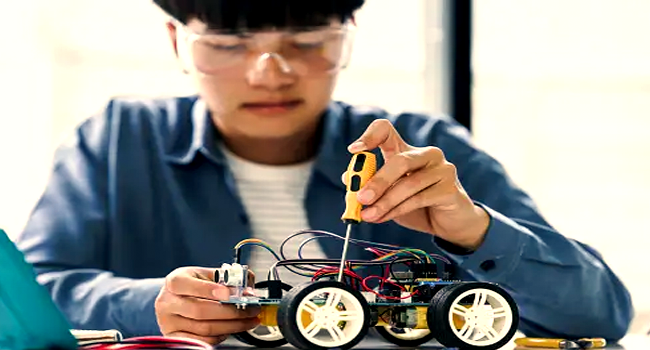In a world ruled through patron electronics, a growing movement of folks opt to take topics into their fingers. DIY electronics tasks have surged in reputation in recent years, fueled by a combination of accessible era, online assets, and a desire for hands-on learning and creativity.
From building custom devices and tinkering with circuits to programming microcontrollers and designing PCBs, DIY enthusiasts embrace electronics as a hobby and a passion.
In this text, we’ll discover the world of DIY electronics projects, their challenges and rewards, and how lovers can craft success on this niche panorama.
1. The Appeal of DIY Electronics Projects
At its core, DIY electronics projects offer a unique combo of creativity, problem-solving, and technical talent development. For many lovers, the attraction lies within the capacity to create something tangible with their arms, whether or not it is an easy LED circuit or a complicated robotic contraption.
DIY projects additionally provide an opportunity to analyze new abilities and gain a deeper understanding of electronics standards, from basic circuitry and soldering techniques to superior programming and automation.
Moreover, the delight of successfully finishing an undertaking and seeing it come to life is unheard of, driving fans to constantly push the boundaries of their capabilities.
2. Accessible Technology and Resources
Advancements in technology have made DIY electronics more reachable than ever before. Components like microcontrollers, sensors, and actuators are to be had and low-priced, allowing hobbyists to test various initiatives without breaking the bank.
In addition, online resources, including tutorials, forums, and mission repositories, offer a wealth of data and inspiration for aspiring DIYers.
Websites like Arduino Project Hub, Instructables, and Hackaday offer step-by-step courses, schematics, and code examples for various tasks, catering to beginners and skilled fanatics alike. With a computer and an internet connection, all of us can dive into the world of DIY electronics and start growing.
3. Challenges and Learning Opportunities
While DIY electronics initiatives provide many rewards, they also come with their honest share of demanding situations and knowledge of possibilities. From troubleshooting hardware issues to debugging software program code, lovers must be prepared to overcome barriers and persevere through setbacks.
However, those demanding situations offer valuable getting-to-know studies and foster growth as a maker. Every assignment provides an opportunity to extend one’s information and skills, whether or not it’s mastering to read datasheets, learning soldering strategies, or honing programming proficiency.
With every success and failure, DIYers benefit from confidence and knowledge, becoming more adept at tackling more complex projects.
4. Community and Collaboration
One of the most worthwhile aspects of the DIY electronics network is the feel of camaraderie and collaboration among fanatics. Online boards, maker areas, and neighborhood meetups allow like-minded individuals to attach, share thoughts, and collaborate on tasks.
Whether it’s participating in open-source hardware designs, contributing to network-driven software program projects, or indeed exchanging pointers and recommendations, the DIY community prospers on the spirit of cooperation and mutual support.
Through collaboration, DIYers can leverage each other’s knowledge and resources to address large projects and gain more achievement than they may on their very own.
5. Crafting Success in a Niche Landscape
Crafting achievement in the world of DIY electronics requires a mixture of ardor, persistence, and realistic talents.
Enthusiasts must be willing to invest time and effort into honing their craft, constantly increasing their know-how, and pushing the boundaries in their abilities.
Building a solid foundation in electronics fundamentals, which includes Ohm’s Law, circuit analysis, and component identification, is essential for tackling extra advanced tasks with confidence.
Additionally, growing talent in programming languages like C/C++, Python, and JavaScript opens up possibilities for increasing interactive and sensible digital structures.
Conclusion
DIY electronics initiatives provide a worthwhile and fulfilling outlet for creativity, getting to know, and self-expression.
From humble beginnings tinkering with simple circuits to bold endeavors designing custom PCBs and robotics, fanatics can explore a vast landscape of initiatives confined simply by their creativeness and determination.
By embracing challenges, seeking out resources and assistance from the community, and constantly honing their talents, DIYers can craft achievement in this niche hobby and enjoy bringing their ideas to existence in electronic creations.
So roll up your sleeves, fire up your soldering iron, and prepare to embark on a thrilling adventure into the DIY electronics sector!
FAQs
1. What are DIY electronics initiatives?
DIY electronics tasks are hands-on activities where people create digital gadgets or systems from scratch, frequently related to components like microcontrollers, sensors, and actuators. These projects can vary from easy LED circuits to complicated robot creations.
2. What makes DIY electronics projects attractive?
DIY electronics tasks offer a unique combination of creativity, problem-solving, and technical skill improvement. Enthusiasts enjoy creating something tangible with their palms and the opportunity to analyze new talents and gain deeper information about electronic ideas.
3. How reachable are DIY electronics initiatives?
DIY electronics projects have grown to be more and more on hand because of improvements in generation and the supply of less costly additives. Online sources, tutorials, forums, and venture repositories make it easier for fans to get started and discover thoughts for their initiatives.
4. What challenges do DIY electronics projects present?
DIY electronics tasks include troubleshooting hardware troubles, debugging software code, and overcoming setbacks. However, those demanding situations provide precious studying stories and possibilities for growth as a maker.
5. How can fanatics hook up with the DIY electronics community?
Enthusiasts can connect with the DIY electronics community through online forums, maker spaces, and nearby meetups. These platforms provide possibilities to percentage ideas, collaborate on tasks, and are trying to find advice and guidance from like-minded individuals.
6. What abilities are necessary for success in DIY electronics initiatives?
Success in DIY electronics tasks calls for a combination of passion, patience, and sensible abilities. Building a solid foundation in electronics basics and programming skillability is essential for tackling initiatives with self-assurance.
7. What are some examples of DIY electronics initiatives?
DIY electronics tasks include building custom devices, designing PCBs, growing interactive installations, and developing robotic systems. Enthusiasts can discover many projects, from novice-pleasant tutorials to superior engineering endeavors.

